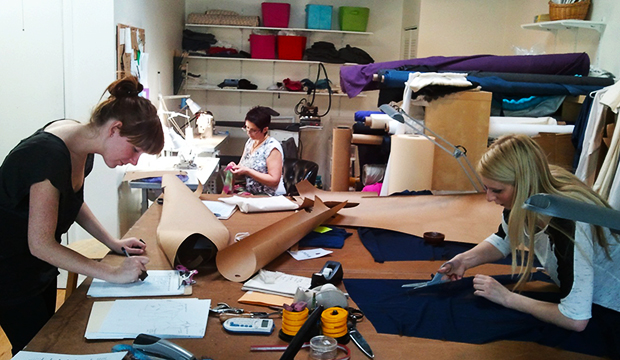
Working with a sewing contractor can be a challenge. But it doesn’t have to be. Knowing the process and identifying expectations early on can make all the difference in a working relationship.
Here are 7 Tips for Working with a Sewing Contractor:
1. Give your contractor a cutting ticket for each order. A cutting ticket should include the style number and name, pattern number, an image of the piece, colors/sizes, quantity, swatches of colors and/or combinations, and sewing details/instructions. Don’t assume that if you tell the contractor verbally what you want that they’ll actually remember it – you need to put it in writing.
2. Samples may cost more than you think. Getting samples made can cost double or triple the price you will pay for production. This is important to know when you are deciding how many styles will be in your line. Also, some contractors really want to be the ones to sew your samples and some don’t do sample sewing at all so check this ahead of time.
3. Be clear about payments. With production manufacturing, you pay by the piece. For sample sewing, you might pay by the piece or by the hour. Be sure to clarify this up front. You also want to remember to discuss when and how you’re required to pay so there are no surprises later.
4. Price breaks for higher quantities may not be your best option. Many manufacturers have a tiered system of pricing, depending on quantity. For example, your contractor may tell you that if you order 100 pieces of a style, it will cost $8.00 less per item to produce. Ask yourself: Do you really need 100 pieces of that style? Do the math. Even though you save some money per piece, you may be sitting on 50 extra pieces at the end of the season. Carrying extra inventory will kill your cash flow and your business.
5. Leave some wiggle room for your production time. Murphy’s Law is never truer than when you are in the middle of producing your clothing line. Give yourself a little padding and you will reduce your stress tremendously. Add two weeks of ease to production time and a week for fabric delivery whenever possible.
6. Treat your sewers with respect. I’ve seen my share of “diva designers” and I pray I never acted like that when I had my line! I cringe to hear about designers who boss contractors around like they own the place. Just because you are paying your contractor to work for you does not give you the green light be difficult. Situations with manufacturing can get very tense and stressful and you have to remember that you and the contractor are a team. When you start treating contractors as partners and respecting their talents, everything will run more smoothly.
7. Pay on time. Keep your word. Word travels fast in this industry and it’s a business built on relationships.


Anahit Jackson
Hi LJ,
This is Anahit, you can call me at 626-272-5240 or email me at: anahitm@dslextreme.com
Thanks.
omolade
this will really help as i am thinking of starting my own line. i am experiencing No.5 with getting a sample right now so i belief all those tips will actually help if i factor each in from the very start. thank you
Omolade
Anahit Jackson
Hi Omolade,
I have a pattern making service, and work with very quality sample makers and contractors that are amazing.
My studio is located in Down Town LA. I help designers understand about fit, fabric, construction, and point out potential disasters with their choices. I help them with all aspects of getting their garments from an idea to producing them.
If you are still in need of help, please contact me through email.
Best,
Anahit.
LJ
I’m a designer looking for help with producing in LA, Anahit please contact me.
Anahit Jackson
Hi LJ,
For some reason I don’t see my 2 replies to you. Am I missing something?
Anyhow, give me a call so we can discuss your needs and how I can help.
Thanks,
Anahit
Goldie
LJ I am in need of some production sewing. I am located up here in Seattle, WA Are you familiar with anyone up here.
Sandra Miemietz
I would like to know if any one knows what my rights are to having my employer of contract sewing not call or contact me at all.
I have all of her products at my home in storage.How long does she have to pick things up, or do I consider them mine?
I have been emailing and calling her for 2 months now and no responce.
Hope some one can help me.
Thanks Sandra Miemietz
Jennifer Philbrook
These are great tips from Jane! Number 5 is my favorite. I have worked with so many designers (and I hate to admit I did it when I had my own line) who don’t leave enough time for production. So many times we run up again deadlines for shipping and all of a sudden we have a “fashion emergency”! I try to avoid those at all costs now! Please, please add in enough time:)
Stephane
great tips Jane, thx for sharing. I’ve learned my lesson going for the cheapest and not writing what I wanted. Now I write everything down and pay a little more but everything is as expected.